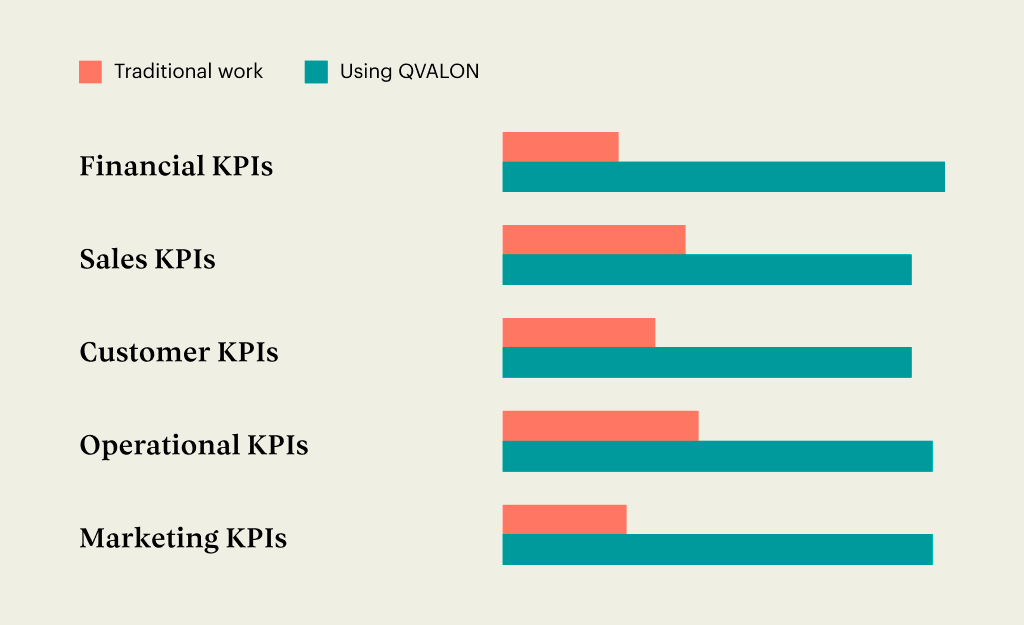Qvalon Blog article content
KPIs are statistical data on the organization’s performance concerning its strategic goals. KPI metrics can be defined for all participating entities of an organization, such as human resources, equipment, infrastructure, etc. They can also be developed by the hierarchical structure, as per which they can be established for individuals, teams, departments, regions, and more. The important thing is that KPI goals reflect business objectives.

Why are KPIs important?
For a regular retail store, the daily operational activities can consume most of the time of field teams, including managers. Customer assistance, inventory management, equipment maintenance, etc. can be urgent tasks and prioritized over others. In such a high-speed environment, it can be challenging to track performance. The overperformance of one employee can compensate for the underperformance of another. In this situation, the former might not get appreciated and the latter might not get needed support.
But if employees are aware of the key performance metrics as per which their results will be measured, they can focus on completing their tasks such that they score better on those metrics. The management can easily analyze high performers, so they can be rewarded, and identify underperforming team members to support and assist with more training or reassignment to other tasks and projects.
The entire KPI structure, its planning and communication to employees, reporting, and analysis can be deployed and managed with QVALON.
12 types of Key Performance Indicators
Corporate KPIs should originate from corporate business goals. Every business is unique in its own way, and so are its KPIs. Businesses can and should be creative while finalizing the performance metrics that they want to track along with the standard ones.
The standard KPIs can be categorized as,
-
Quantitative Indicators
They represent data in numeric values. Percentages, ratios, whole numbers or fractions to show ratings, scores, counts, finances, and such.
-
Qualitative Indicators
Unlike numeric values in qualitative indicators, these indicators are expressed in textual data such as surveys, opinions, multiple answer questionnaires, etc.
-
Lagging indicators
These are an organization's current metrics compared with similar metrics from a previous time frame.
-
Leading Indicators
They help forecast future trends based on current and past statistics, thereby predicting future outcomes of a company’s business processes.
-
Input Indicators
Input indicators help analyze the required resources to produce the desired results. For example, how much additional staff is needed to deal with additional customer footfall during the festival period, or how many more machines to double the production.
-
Output indicators
As the name suggests, these indicators reflect the final result, which in turn suggests the success or failure of a business process, such as revenue growth, number of customer acquisitions, review score, etc.
-
Process Indicators
They communicate how well a business process is running and how effective they are in fulfilling its purpose.
-
Directional Indicators
They are comparative indicators of a company’s performance concerning its competitors.
-
Practical Indicators
They mainly question the purpose of a company’s existing processes with regular feedback and observations.
-
Actionable Indicators
They help reflect an organization’s ability to implement change, whether it is operational, cultural or political.
-
Financial indicators
As the name suggests, they show a business’s financial stability and growth. When coupled with other metrics, these indicators suggest detailed financial sustainability.
-
Outcome indicators
They help identify if the business and/or its specific processes are meeting its objectives in the short and long term.
Examples of KPI

The best way to understand types of KPIs that are specific to different industries or departments is to have a closer look at your business and have a closer look at these examples:
-
Financial KPIs
Probably the most crucial aspect of any business, company or organization. There are many KPIs to track and analyze the financial health of an enterprise from different perspectives. Some of them are gross profit margin, return on assets (ROA), cash conversion cycle (CCC), debt-to-equity (D/E) ratio, etc. The other metrics, their KPI analysis can suggest the financial performance of individuals, teams, regions, departments, and more.
QVALON can optimize existing processes of a business of any size that have a direct or indirect improvement on financial metrics. Burger King saved 9% on their cleaning costs after integrating QVALON.
-
Sales KPIs
Most business KPIs are focussed on sales as it is usually the main source of revenue for any company. Few sales-specific KPIs are sales target, lead conversion, upsell, sales volume, etc.
QVALON helps to enhance all key operational activities and boost the efficiency of every participating entity. Employees are up-to-date about any process revisions, equipment is well-maintained and infrastructure runs smoothly. All of these eventually result in better sales.
-
Customer KPIs
KPI data related to customers helps to evaluate the quality of their user experience and sales journey. Few KPIs that keep track of this are average response time, customer retention rate, cost per conversion (CR), amount of positive customer reviews, net promoter score (NPS), etc.
QVALON helps maintain consistency in customers’ brand experience. It helps to nurture positive customer reviews and generate word-of-mouth. QVALON supported retail operations for ZENDEN to boost its customer loyalty.
-
Operational KPIs
The efficiency of a company’s operational activities directly affects its profitability. Along with that, operational health is also crucial to subtle aspects like employee motivation, customer experience (CX), waste control, etc. Some of the Operational KPIs are employee turnover rate, rework rate, operating margins, ROIs of outsourcing, etc.
World-class and Henderson improved their operational efficiency by 46% and 85% respectively after they integrated QVALON. With closer team coordination and advanced analytics available with QVALON, these companies can quickly proceed with the upgrades, improvements, and growth.
-
Marketing KPIs
Organizations measure KPIs related to marketing to understand if the efforts invested into promotions are leading to expected results and to take subsequent actions based on their analysis. Some Marketing KPIs are cost per lead (CPL), cost per acquisition (CPA), average order value (AOV), customer lifetime value (CLV), etc.
With features like photo-reporting, geolocation checks, data validation, and more, QVALON helps companies to implement marketing and visual merchandising standards across all the organization. Amway is able to collect data from their entire retail network within one day with QVALON, it helps them to adjust ongoing local advertising campaigns, allocate additional support, and make quick changes in promotional displays and product offers almost immediately.
Development of key performance indicators
With so many KPIs available, it can be tempting to measure everything. But this can lead to data overload. Management can be overwhelmed with data and find it difficult to decide what actions to take based on which data. To manage KPIs effectively corporate management shall develop KPIs that are most important and are aligned with business goals. Here are the steps to help with KPI development:
-
Discuss and define:
Interact with employees for whom KPIs are being developed. They will have detailed insights into daily work processes that might not be available in documented process plans. It will make KPIscloser to real-life scenarios. -
Align KPIs with strategic aims:
Every KPI should directly or indirectly correlate with the business’s goals, both long term and short term, otherwise, the entire exercise will not deliver the expected results. -
Articulate clearly:
As a general rule of thumb, KPIs should be Specific, Measurable, Attainable, Realistic and Time-Bound. -
Avoid ambiguity:
KPIs should be structured such that the chances of misinterpretation by different entities is as less as possible. Similarly, there should be clear guidelines on how to read KPI data and draw conclusions. -
Respond to change:
Key performance indicators in retail have changed significantly during and after the pandemic with an increased focus on hygiene. Similarly, other KPIs should also get regularly updated to reflect changing business dynamics and customer behaviors. -
Avoid overload:
It is not important to measure and analyze every bit and type of data. It will only lead to confusion and probably incorrect conclusions. Agree on KPIs that are important based on the nature of business and ensure to be regularly updated on them.
Tips for improving key performance indicators
No matter how automated and machine-driven an operation process is, still its effectiveness and efficiency are largely influenced by employees, as eventually any machine is either operated or serviced by employees. Hence most, if not all KPIs are directly or indirectly influenced by the human resource of a company. Optimizing the human factor and ensuring that it is performing to the best of its capabilities becomes crucial for any business.
QVALON empowers businesses to closely review and assist employees' performances. High performance can be duly rewarded with recognition and promotion. Low performance can be addressed with support, training, assistance, or relocation. Responsibilities can be quickly communicated to address all possible scenarios. QVALON supports a work environment, all participating entities are aware of their short-term, and long-term goals which are aligned with the company's strategic objectives. With clarity on expectations between management and workforce, along with the transparency of performance results, employee output improves which translates to better KPIs.



